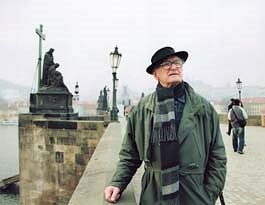
Professor František Dvořák brings monuments closer to the general public
 |
"I can't draw, and I have no feel for sculptural expression in clay," confessed Professor Dvořák, whose range of publications on visual arts is extraordinarily broad. For example, he wrote books about Prague's monuments, such as Walking Across Charles Bridge, Walking the Royal Route, Walking Prague Castle and its Surroundings, and About the National Theatre. He also published A Brief Overview of the Development of Artistic Styles in the Czech Lands and a publication on French modern art in Czech collections.
He formed personal friendships with many artists he wrote about, such as František Tichý, Jan Zrzavý, Kamil Lhoták, and Václav Špála. He recorded his memories not only of them in the books My Life with Art and Moments with Artists. However, he did not only write about Czech artists; he is the author of a monograph on Henri Matisse's drawings, and his book on Hans Holbein's drawings was published in publishers in Paris, Vienna, Bayreuth, and American Minnesota.
František Dvořák was born in the village of Červenka near Olomouc. During the war, he took a teaching course and briefly taught. After the liberation, he went to Prague to study comparative literature, but eventually chose the history of art and aesthetics. He was not eligible for a scholarship because his father, a train driver, reportedly had a decent salary. However, his parents wanted him to return to the teaching profession. "Every letter from my mother ended with the words: František, give up your studies and come home," Dvořák explained why he had to earn money for his studies; he wrote for magazines and worked externally at the National Gallery.
He eagerly attended literature lectures and, among other things, met Jaroslava Natálie Křížková there, whom he married in 1948 and with whom he has two sons. Both are following in their father's footsteps—his younger son Daniel (61) is a stage designer and has also served as the director of the National Theatre in Prague and the National Theatre in Brno, and his older son Jan (64) is a theater theorist.
Immediately after graduating in the history of art, František Dvořák gained valuable experience as an assistant to the famous art historian Václav Vilém Štech at the Academy of Fine Arts in Prague. "I had a twelve-hour-a-week position with Štech, so I was mostly at home, and artists used to come to see us," Dvořák recalled, noting that he wrote his first books at that time, including one about the Baroque portraitist Jan Kupecký. However, because he refused to join the Communist Party, he was expelled from the academy.
"Watch out for theorists, namely František Dvořák, who expresses strange opinions that are not in line with socialist realism," the regime wrote about him at the time. From 1960, he worked at the National Gallery, where he led the Department of Modern Graphic Arts. He taught the history of art at a secondary school of applied arts in Prague for several years until he won a competition for a position in the Department of Art History at the University of Olomouc in 1969. He commuted from Prague to lecture there for sixteen years.
In 1993, František Dvořák was appointed professor at the Faculty of Arts at Charles University in Prague, where he lectured until he was ninety. In 2010, he received the Artis Bohemiae Amicis award from the Minister of Culture for promoting the good name of Czech culture, and the same year, President Václav Klaus awarded him the Gold Plaque of the President of the Republic.
The English translation is powered by AI tool. Switch to Czech to view the original text source.
0 comments
add comment






